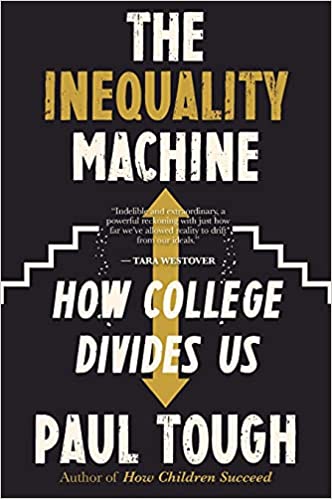You have /5 articles left.
Sign up for a free account or log in.
 The Inequality Machine: How College Divides Us by Paul Tough
The Inequality Machine: How College Divides Us by Paul Tough
Published in September 2019
I've been trying to figure out how I missed Paul Tough's The Inequality Machine until now.
The book is such a lucid, compelling and tightly argued critique of elite higher ed that you'd think it would have made a big splash. If you are like me and have missed The Inequality Machine until now, please rectify that situation. This is a book that we need to talk about.
The reasons that I did not find The Inequality Machine until now are, I think, threefold.
First, the audiobook version was only released in March of this year. There is a much higher probability that I will read a book with an audiobook version than without. Increasingly, I'll favor books that are audio/ebook synced (Whispersync) over those lacking that option.
Second, and somewhat confusingly, the book's title changed for the paperback release (also in March) from The Years That Matter Most: How College Makes or Breaks Us to its current (much better) title.
And third, well … COVID. We've all been a bit distracted. Book recommendations are shared by word of mouth. We've not all been together enough to share what we are reading.
If anything, the themes discussed and conclusions reached in The Inequality Machine are more relevant than ever. Nineteen months or so into the pandemic, the structural inequalities that at least in part define our higher education system have only grown more pronounced.
Tough's main conclusion about U.S. higher education will not surprise anyone who is a student of our system. Among the claims that Tough levels about higher education are:
- Colleges and universities are financed and designed in ways that benefit mostly those with the most resources.
- Elite higher education, comprised of the wealthiest institutions, educates the smallest number and proportion of low-income students.
- The SAT and ACT have very little predictive value above students' high school grades in predicting college success. At the same time, these tests do an excellent job increasing barriers to admission for poor kids while advantaging students from families with the resources to pay for private tutoring.
- Research-intensive colleges and universities have done a poor job of providing disadvantaged students with the necessary resources to succeed in STEM courses.
- The trend toward state disinvestment in public institutions has hollowed out the ability of many colleges and universities to provide the necessary resources to enable students to get to graduation while also shifting the financial burden of higher education from the public to students and their families.
Throughout The Inequality Machine, Tough illuminates the costs of our higher education system on the lives of individual students and their families. The college-going experiences of immigrant, first-generation, minority and low-income students are described from their perspectives.
Tough's insistence on having those most disadvantaged by the higher education system speak for themselves gives the book an emotional resonance.
As good as The Inequality Machine is -- and it is very good -- I would have liked if Tough could have spent more time on potential solutions.
The chapter on one professor's efforts to reimagine calculus instruction at UT Austin is inspiring. What is missing is a discussion of the widespread efforts across many colleges and universities to reinvent a range of foundational and gateway courses. (A trend that Eddie Maloney and I discuss in Learning Innovation and the Future of Higher Education.)
While strong critiques of our system of higher education from outside the academy are both needed and welcome, Tough could have perhaps done more to connect with those of us working to make changes from within. We need to recognize and amplify the work of colleges and university leaders working to make institutionwide changes to lower costs, advance learning and improve student success.
To be fair, Tough does highlight some institution-level reforms, from schools as diverse as Trinity College and UT Austin. While I would have liked to have seen more case studies of colleges and universities tackling structural inequalities, the examples provided in The Inequality Machine should be discussed (and perhaps replicated) broadly across our ecosystem.
What are you reading?








